We met in an alley in XinJiang.
For her, the 14 days prior to our meeting consisted of 12 days in a Beijing hospital, 10 of them being in ICU alone. No nanny, no person, no mama. Just alone. IV in the head, arms restrained, and a diaper rash that was really a bedsore when you get down to it.
Discharged and returned to her foster home to get cleaned up, packed up, and off she went, returning to the province where she was found. It had been 11 months since she left her first home. Scared, sick, and recovering from two weeks of life turned upside down and inside out. Trauma doesn’t even begin to describe it.
We always hear about the things adoptive parents can do to begin to attach. There’s cocooning and co-sleeping; there’s making sure mama and daddy alone meet the basic needs of feeding and comfort at first. I read the books, I did the online education, I listened carefully to the calls with our caseworker. My concern in the first days was: How would we communicate? How would we understand what her needs were, and how would we begin to communicate to her that now we were the people who would meet those needs? How in the world will we connect and bridge the communication gap, and where do we even begin?
We began in the alley. It wasn’t ideal but it was how we began. My first act of motherhood as her mother was comfort – except I wasn’t of much comfort to her. Hot of the heels of hospital discharge and airplane rides, and pneumonia – I was the very last thing she wanted. She wanted to just be home with her little friends and her nannies and her toys. She had no idea that that life was over, and soon she would no longer even remember it.
Holding her as she cried tears full of fear I imagined her thinking “what now?” Bounced around from foster home to hospital back to foster home to airport to hospital to orphanage to alley. What now indeed.
“It’s ok. Mama’s here,” I repeated hoping that “mama” would be a familiar sound. The more she cried the bluer her lips. I handed her back to the orphanage representative for a reprieve for us both. I know now that she was told “It’s ok she is your mama! Don’t cry! You will be so happy! They are nice people. Don’t cry.” What must she have thought in those first moments…
They say 93% of communication is nonverbal. This was to our advantage as nothing we said verbally made a difference. The iPad we brought, however, was our first connection. A distraction, a bridge, a tool that stopped the crying in favor of curiosity. Swipe, swipe, swipe. In seconds she was a master swiper and the gap became a little smaller. A picture of a strawberry, a pig, a block, a girl, an cookie – anything we could both mutually recognize as familiar. The gap got smaller.
“Are you hungry?” A familiar cracker. An apple cinnamon puff. A banana puff… something new and something yummy. Her little fingers snatched it up without even a look at first. “More?” we would sign for her in those first moments. “Please?” we would sign. Then a brief look up as she took another banana puff and another. Then she would look long enough to see a smile. Then she would beat her little fists together copying us to say “more”…and the gap got smaller.
Our older children were 14 and 12 at the time. Having them along made the gap smaller. They didn’t have the fears I had, they didn’t notice the blue lips and fingers and toes. They knew that little kids giggle when they get spun, get tossed in the air a little, and see silly faces of peek-a-boo. She laughed, she really really laughed. The gap got smaller.
Communication is a challenge for every relationship. We don’t all speak the same love language – we may not even speak the same language. I could tell quickly that she craved closeness and attention. We poured it into her constantly.
I would later learn that being alone was terrifying for her. Knowing a little about the 14 days before the alley, is it any wonder being alone is a trigger? It is still terrifying. I would later learn that above her health challenges, fear would be her constant battle. We are well matched that way. “My not wanna be all alone,” she says daily; although since the alley, she has never ever been all alone. She may be alone in her room and wake in a panic. Seconds later we rush in and quickly remind her, “You’re safe. You’re not alone. We are here.”
I’ve done some independent study on how trauma affects the brain because even though we met in the alley when she was 19 months old and 16 pounds, there was already enough trauma to color her responses and drive her behaviors. You’ve read a snapshot in this post already. Prior to that week before the alley there were six hospitalizations I know of but there are probably more. A pacifier taped on her mouth and hands restrained in one photo, an IV in her head in another. I don’t know how long she waited before she was found at one week old. She was found in a busy place so, probably not more than several hours or a day.
What I know now, after my bit of research, is that trauma affects the part of the brain where our fight and flight response is generated. The amygdala is in charge of triggering what’s necessary for us to survive, and at the very sniff of real present danger, it sends our bodies into fight or flight.
Kids with a history of trauma have a particularly sensitive fight or flight response and rather than it triggering when there is real present danger, it can and does often trigger when there is perceived danger of any kind. Trauma has a major impact on that tiny organ.
Enter Grace, who has a history of trauma she doesn’t remember but perceived danger is disguised as real present danger more so than most children her age. There may as well be someone kidnapping her when she watches Finding Nemo. It’s not just a little fear, it’s all out panic. When I see her fear responses now, at almost 5 years old, I see them through the lens of her trauma. She may not clearly remember her traumatic experiences, in fact, I’m sure she doesn’t; but her amygdala is on high alert and sends her into panic, self-preservation, fight and flight on steroids in one hot second.
What can we do about that?
The older she gets the more communicative and interactive we are. Now, at almost 5 years old we talk about things she is “too gayohd” (scared) to see or do or hear. Finding Nemo is particularly terrifying. You would think the first really scary part would be the opening scene when Nemo’s mom get’s eaten. She didn’t really pick up on that right away. I assumed the shark scene would be one we would fast-forward. We didn’t make it that far. For Grace, the scene where Nemo touches “the butt” (the boat) and subsequently gets fish-napped is what sends her into full panic, and I do mean panic. Now she knows Nemo finds his daddy at the end. She knows there’s a happy ending. It does not matter in the moment because Nemo is taken from his daddy, and it is more than she can bear.
Is it because she deep down remembers that first loss of her birth family? I don’t know, it’s certainly possible. Studies have shown that anniversary trauma is a real thing. Is it because in a subconscious way she can’t understand, she identifies with that loss and that deep fear of being separated from one’s family (again)? I think probably. She cannot possibly make sense of things when fear overtakes her, who can? Her ability to reason goes temporarily offline. You would have to see the reaction that takes place to probably get an idea of how intense of a reaction this is.
“Does Nemo find his daddy in the end?”
“Yes…”
“Is this real?”
“No just pretend. My too gayohd (scared). Please put on George (Curious George which has yet to be scary in any type of way).”
“Does Mama love you?”
“Yes.”
“How much?”
“So huge…”
“That’s right – and if mama loves you so huge, would I let you watch anything to scary for you?”
“No… I wanna watch George.”
Now with our first two kids I loved this part of Nemo! It created the perfect opportunity to point what happened to Nemo when he got sassy and disobedient and belligerent towards his very loving, over protective parent (also known as me). It didn’t scare my two birth children in the slightest. Good on you Disney, for bringing home the lesson of what happens when kids are disobedient. You scared the parents half to death but mostly the kids are fine until the glow in the dark weird fish and the sharks.
We didn’t even get to the sharks in Finding Nemo, with Grace, and that’s okay. Obviously we have some work to do. The good news is, trauma isn’t a life sentence. I don’t believe she will always have these fears that propel her into panic.
We do a lot more talking through things today than we did a year ago. We do a lot more rationalizing at almost five than we could do at almost four. I believe there is a lot of healing in her future and I know we have to be intentional about seizing opportunities to teach her that she is an overcomer and her heavenly Father is restoring her from the inside out.
It can feel defeating when we have rushed to her cries to assure her that we are here, co-slept, and tell her always that she is safe and she will never be truly alone; but still she panics when waking in her room alone. It’s easy to miss the progress that has happened when she needs to still sleep with us to sleep well and feel safe. Her felt safety always trumps privacy, sleep, etc. However, we cannot just let her stay where she is in the land of unrealistic fears. It’s not what we think is best for her, it’s not what God thinks is best for any of his children.
As it happens in the USA, Halloween starts to hit the shelves after Independence day. Costco has a life-sized grouping of talking skeletons with creepy blinking red eyes and eerie sound effects. One look at that sent Grace running in a panic in the other direction.
“My not like Halloween. Too garey (scary).”
“Is it real or pretend.”
“Not real but my too gayohd. Please not go costco.” (well we can’t have that, now can we)
The next time we were in Costco we had practiced pulling the neck of our shirts up over our eyes because if we see something scary we can cover our eyes until it’s gone. With one eye half peeking out every so often, we made it through Costco without getting too close to the display. Victory.
We couldn’t just not go out of the house and avoid the scary things. There’s always going to be scary things. I have to show her we can still go where the scary things are, I even touched them and jiggled them and moved the display a little to show her it was pretend (once I looked around to make sure I wouldn’t get busted).
Whatever the damage trauma has done cannot just be deleted or erased. We can’t talk our kids our of their default reactions to fight or take flight. Self-preservation is a God given instinct and it’s a good thing. And for our little one… it has kept her alive and fighting in a good way. Maybe you can relate. Our former orphans are overcomers, survivors, warriors – complete, many of them, with battle scars. They have already overcome so much, they will surely overcome fear in spite of their history, and we can help them buy creating new pathways in their brains and new responses to triggers.
Our state fair is this week and last year, Grace was too “gayohd” of the rides. Grace likes predictable, routine, normal; and a year ago fair rides didn’t fall in her comfort zone. This year though, she was all about the rides. One particular “ride” wasn’t a ride as much as it was a sort of vertical obstacle course attraction. “My go all my jelt! (myself)” and off she went. We could see her the whole time she was in this Pirate themed obstacle course. She was about 30 seconds into it when she stopped dead in her tracks. In the corner, right next to the stairs she had to climb up next, was the head of a skeleton wearing a pirate hat. A booming voice came from the speaker near by giving instructions in pirate speak, “Up the stairs mate-y…”. It wasn’t a haunted ride, it wasn’t meant to be scary like the Halloween display. She stood frozen. She knew at the end was a super cool long transparent tube slide onto a soft landing exit. We had watched kids start and finish already. There were so many fun things ahead for her but she couldn’t move forward. She looked out at us. I could see her start breathing big scary breaths. Her brows started to furrow and her eyes saddened, “My too gayohd. My not like that, too garey.” The teenager running the ride looked at her, then looked at us, and then back at her.
“Grace, it’s not real, it’s pretend. You don’t even have to look at it. It’s not alive. It’s not real. Try to cover your eyes.” She closed her eyes and inched forward, froze again and began to cry. Then came the body flailing and the hopping and she started to back her way out. This would become a moment. This would become one of those moments when she would learn one of two lessons. She would either learn that it’s not worth getting through the scary things to the really great things. She could learn that scary things have power over her. Or, she could learn that we can’t give the scary things that kind of power. Some of us grown ups need to learn that we can’t give the scary things that kind of power.
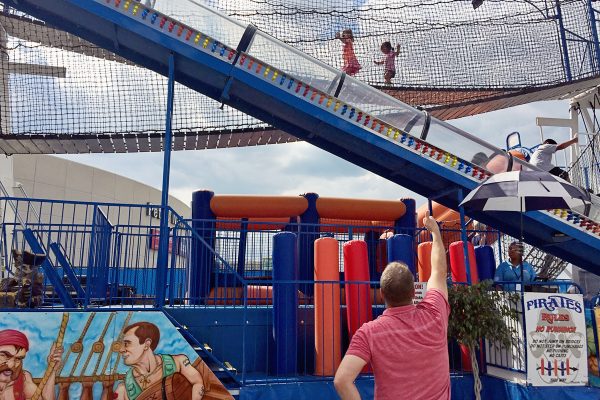
The teenager operating the ride saw the kerfuffle and motioned to Robert to come up on the ride. Grace wanted to get out, but I knew that would be a missed opportunity. So daddy came to the rescue (another solid lesson for our girl), grabbed her by the hand and did not carry her off the ride – but took her through it. Passed the scary part, up the stairs, over the bridge and down one slide. Then up more stairs, across the other bridge, up a few more stairs and down the super cool transparent tube slide to the soft landing. I’m not sure whose smile was bigger hers or mine because watching your child conquer her fears – with help – is even better than conquering your own.
We went over to the scary thing together and just like at Costco, I moved it around, tipped it upside down (it was hollow). She still didn’t like it and I don’t blame her. It was ugly and weird, but she went right back on that pirate thing alone. I saw her look over at the scary thing it as she approached it again. She marched herself right past it as if it was insignificant. She went on that Pirate ride thingy again, and again, and again. It’s my favorite thing at the fair now. It will forever be, to me, a reminder that she is making progress – even if she still needs to sleep with people in the room, she is making progress in other ways.
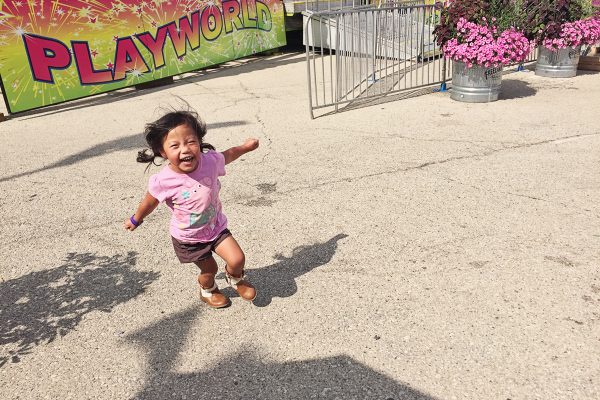
This day will reteach me, as things with Grace often do, about how God deals with us and our fears. Grace’s daddy didn’t remove her from the scary thing. Instead, he carried her through it and past it. God does that with us. He does that with me. He models that for us as His sons and daughters. He always has. He didn’t take the Israelites back to where they were because they were terrified that the Egyptians were after them in hot pursuit. When they came upon the Red Sea, God didn’t lift them up over it. He parted the sea and had them walk right through it.
It’s hard as a mom to watch your kids be fearful and we want so much for them to feel safe and believe they are safe. We who adopt sometimes have some demons to do battle with because our kids came from hard places and they endured difficult things without a family, without us – but no more.
It might seem like progress is slow, like walking through quicksand kind of slow – but it’s still progress. As we take our children through the trials and dare to teach them that they can go through the scary things, and learn that the scary things hold no power over them – I pray that we would hear that lesson as well. As God leads us through scary things and hard things, let us not be so quick to want to give up and miss what’s ahead.
What’s ahead, past the hard and scary things, might just be the ride of our life.


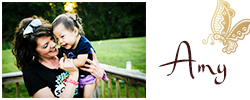

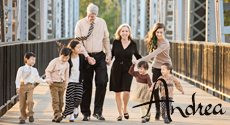
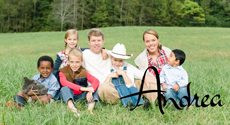


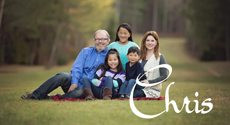
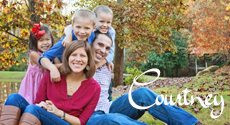





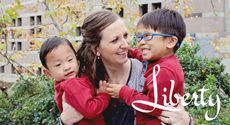
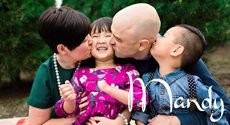
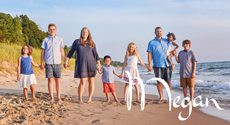
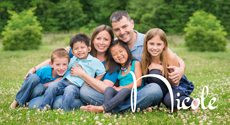

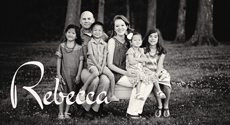


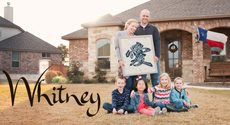


I love your ending! What a profound reminder and lesson!
What an amazing journey you’ve been on! Love, love how you explained the process.
Love this so much!!!
Thank you! It helps me understand my little one a little bit more…
I’m so glad! The struggle is real!
So enjoyed this story, sometimes we get off track and feel we are in a hopeless situation. I always say there is a reason babies need mommies, and unfortunately we live in a fallen world where that’s not always possible. My daughter struggled through lots of obstacles being in an orphanage her first year.
Sleeping and discipline became very different from my other children.